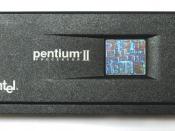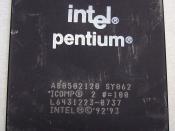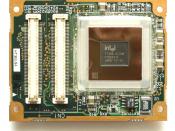Microprocessors, also called central processing units (CPUs), are frequently described as the 'brains' of a
computer, because they act as the central control for the processing of data in personal computers (PCs) and
other computers. Chipsets perform logic functions in computers based on Intel processors. Motherboards combine
Intel microprocessors and chipsets to form the basic subsystem of a PC. Because it's part of every one of
your computer's functions, it takes a fast processor to make a fast PC. These processors are all made of transistors.
The first transistor was created in 1947 by a team of scientists at Bell Laboratories in New Jersey. Ever since 1947
transistors have shrunk dramitically in size enabling more and more to be placed on each single chip.
The transistor was not the only thing that had to be developed before a true CPU could be produced. There also
had to be some type of surface to assemble the transistors together on.
The first chip made of semiconducitve material
or silicon was invented in 1958 by Jack Kilby of Texas Instruments. Now we have the major elements needed to produce
a CPU. In 1965 a company by the name of Intel was formed and they began to produce CPU's shortly thereafter.
Gordon Moore, one of the founders of Intel, predicted that the number of transistor placed on each CPU would double
every 18 months or so. This sounds almost impossible, however this has been a very accutate estimation of the evolution
of CPUs. Intel introduced their first processor, a 4004, in November of 1971. This first processor had a clock speed
of 108 kilohertz and 2,300 transistors. It was used mainly for simple arithmetic manipulation such as in a calculator.
Ever since this first processor was introduced the market...


